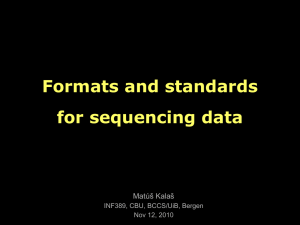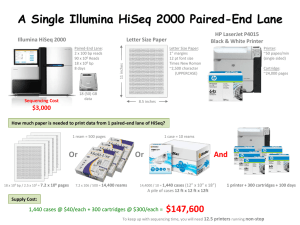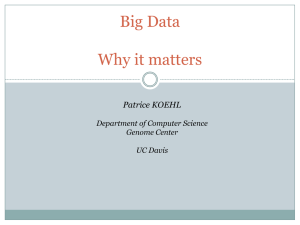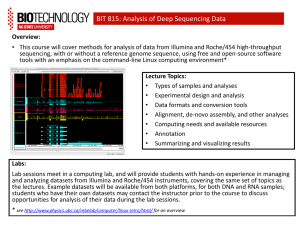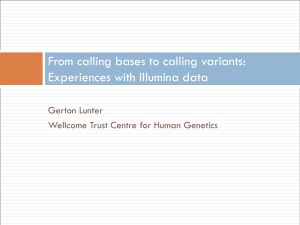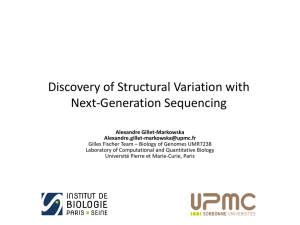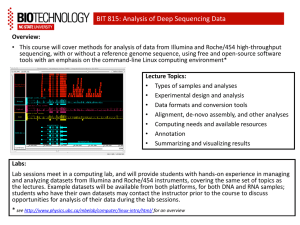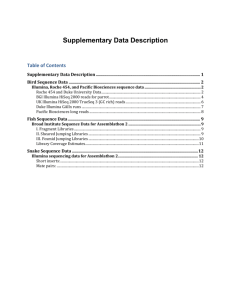ppt
advertisement
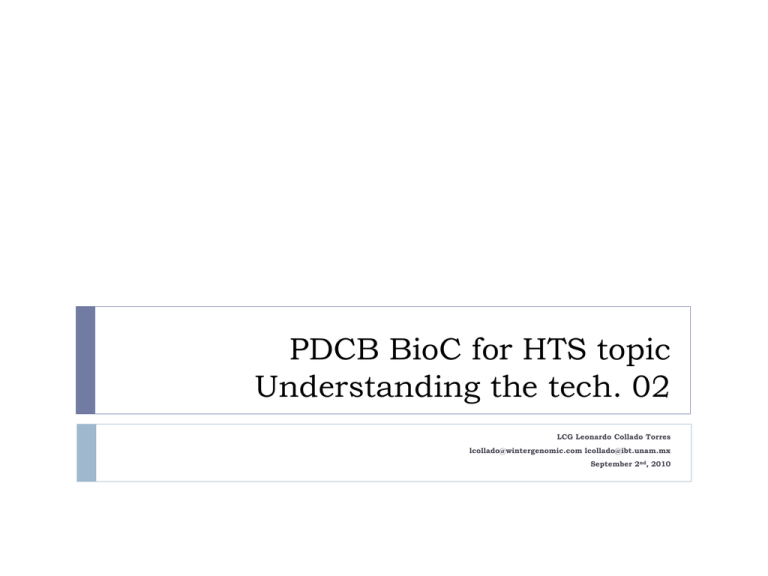
PDCB BioC for HTS topic Understanding the tech. 02 LCG Leonardo Collado Torres lcollado@wintergenomic.com lcollado@ibt.unam.mx September 2nd, 2010 Topics Basecalling Quality Filtering FASTQ format Error rates A gamma of problems / reports Fragment of James Huntley’s ppt on best practices Basecalling: Illumina Cross-talk SWIFT: cross-talk correction Phasing and Prephasing options Some warnings! Describe each case Quality Filtering: Purity and Chastity What artifact can be derived from this step? FASTQ format @ is the seq id sequence + is the qual id Quality in ASCII chars Originally… Q to error probability (p) formulas Qphred Qsolexa1.3 FASTQ types What is the quickest way to distinguish fastq-sanger from fastq-illumina? Tip: Check the ASCII table phred.R It is NOT clear what quals of 1 and 2 mean in Illumina (version 1.5+) FASTQ in CS Base 1 does not include a quality value! (It’s a 0) Error rates Illumina vs SOLiD: % per cycle Illumina vs SOLiD: num of errs Understanding 454 (GS20) a bit more 454 error types 454 errors Presence of Ns correlates with error rate (454) Illumina vs SOLiD Helicos A gamma of problems / reports Aligned to the wrong reference Did not use the correct quality encoding Barcodes are trimmed or have mismatches Trimming the 1st and last base losing barcodes GC bias Sample degradation will affect your data! What is wrong here? Random primers Quality drop off on the 2nd pair Mate Pair libraries Can I stop using the control lane? Hybrid 454 / Illumina Overlap read ends to increase qual HiSeq QC steps by a lab with the HiSeq “Many, many dumb newbie questions” http://seqanswers.com/forums/showthread.php?t=1658 Definitely helpful Fragment of James Huntley’s ppt on best practices Some interesting things you might see Undulating coverage across a reference sequence 3’-bias for a mRNA-seq library BA trace for an over-amplified library Single- and bimodal distribution of read coverage for short- and long-insert PE libraries Base sequence bias for the first few cycles in a mRNA-seq sequencing run Excessive adapter contamination in library Completely failed library: what does that look like when clustering/sequencing? Undulating coverage across a reference sequence no fragmentation fragmentation H1N1 vRNA sequencing libraries 3’-bias for a mRNA-seq library Histogram showing coverage along an ‘‘averaged’’ reference transcript for 1.2 Gb of cerebellar cortex cDNA sequences. ‘‘Short transcripts’’ are all transcripts of <500 bp to which reads were aligned. ‘‘Long transcripts’’ are all transcripts >10 kb to which reads were aligned. Numbers in parentheses are the number of transcripts represented by each category. Mudge et al., 2008, PLoS One. Bioanalyzer trace for an over-amplified library Library Evaluation (Phenotypes- Over-amplified library) Increasing Template 1x Increasing Cycles 10 12 14 16 18 Courtesy Keith Moon 1.5x 2x Base sequence bias for the first few cycles in a mRNA-seq sequencing run Excessive adapter contamination in library List of common reasons why sample prep fails Poor input sample quality/quantity Sample loss, poor laboratory technique Using the wash buffer (PE) rather than the elution buffer (EB) when eluting the final library off the QIAquick columns Insufficient resuspension of the SeraMag beads Using the wash buffer instead of the binding buffer when preparing/washing the SeraMag beads RNA sticking to surface of microfuge tubes Excessive degradation (thermal and enzymatic) Using the wrong heat block(s) Not spinning down the QIAquick column enough to adequately remove all residual EtOH prior to loading on the size-selection agarose gel (library blows out of well) Preparing the wrong concentration of agarose in the size selection gel (leads to grabbing the wrong band) The list goes on! References James Huntley’s “Sequencing Sample Prep Best Practices II”, Illumina Pipeline CASAVA User Guide 15003807 ( Pipeline V. 1.4 and Casava V.1.0) Hansen, K.D., Brenner, S.E. & Dudoit, S. Biases in Illumina transcriptome sequencing caused by random hexamer priming. Nucleic Acids Res (2010).doi:10.1093/nar/gkq224 Cock, P.J.A., Fields, C.J., Goto, N., Heuer, M.L. & Rice, P.M. The Sanger FASTQ file format for sequences with quality scores, and the Solexa/Illumina FASTQ variants. Nucleic Acids Res (2009).doi:10.1093/nar/gkp1137 Huse, S.M., Huber, J.A., Morrison, H.G., Sogin, M.L. & Welch, D.M. Accuracy and quality of massively parallel DNA pyrosequencing. Genome Biol 8, R143 (2007). Whiteford, N. et al. Swift: primary data analysis for the Illumina Solexa sequencing platform. Bioinformatics 25, 2194-2199 (2009). Wu, H., Irizarry, R.A. & Bravo, H.C. Intensity normalization improves color calling in SOLiD sequencing. Nat Meth 7, 336-337 (2010). 1. Abnizova, I. et al. Statistical comparison of methods to estimate the error probability in short-read Illumina sequencing. J Bioinform Comput Biol 8, 579-591 (2010). References http://sgenomics.org/mediawiki/index.php/Main_Page http://es.wikipedia.org/wiki/ASCII http://en.wikipedia.org/wiki/FASTQ_format http://www.politigenomics.com/2010/01/hiseq-2000.html http://seq.molbiol.ru/ http://seqanswers.com/forums/showthread.php?t=4142 http://www.gatcbiotech.com/en/bioinformatics/services/assembly.html http://seqanswers.com/forums/showthread.php?t=6294 http://seqanswers.com/forums/showthread.php?t=612 http://seqanswers.com/forums/showthread.php?t=3375 http://seqanswers.com/forums/showthread.php?t=2973 http://chevreux.org/GGCxG_problem.html http://seqanswers.com/forums/showthread.php?t=2522
